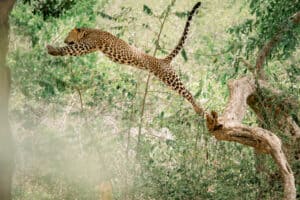Tarsiers can be found in southeast Asia, while aye-ayes are found in Madagascar. Both species are nocturnal and arboreal animals, meaning they are more active at night and spend most of their time on trees. These species are master nighttime hunters like owls and are a menace to creatures like lizards and insects.
Sometimes, people confuse aye-ayes with tarsiers or baby chimpanzees and vice versa. This article examines all the differences between tarsiers and aye-ayes to help you discern between the two.
Comparing Tarsier vs Aye-Aye
| Tarsier | Aye-Aye | |
|---|---|---|
| Classification | Kingdom – Animalia Phylum – Chordata Class – Mammalia Order – Primates Family – Tarsiidae Genus – Tarsius Scientific name – Tarsius | Kingdom- Animalia Phylum- Chordata Class- Mammalia Order- Primates Family- Daubentoniidae Genus- Daubentonia Scientific name- Daubentonia madagascariensis |
| Size | Weight – 80 to 165 g (2.8 oz to 5.8 oz) Height – 3.5 to 6.3 inches (9 cm to 16 cm) | Weight – 4 to 6 pounds (2 to 2.7 kg) Length – 12 to 15 inches (30 to 40 cm) |
| Color | Brown, gray, golden | Black, dark brown |
| Diet | Carnivore | Omnivore |
| Distribution and habitat | – Forest, mangrove, and scrub – Found in Maritime Southeast Asia | – Prefer dense tropical and coastal rainforest – Found only on the island of Madagascar |
| Reproduction and life cycle | – The gestation period lasts for about six months – The age of weaning is eight weeks – Attain sexual maturity between 1 and 2 years | – The gestation period lasts for about five months – Young ones are weaned at about seven months – Attain sexual maturity between 2 to 3 years |
| Lifespan | 12 to 20 years | 10 to 23 years |
| Conservation status | – All tarsiers are vulnerable to extinction – Some species are listed as critically endangered | – Was initially thought to be extinct in 1933 but was rediscovered in 1957 – Currently listed as endangered species |
The Key Differences Between Tarsiers and Aye-Ayes
The elusive and sorely misunderstood tarsiers and aye-ayes have so much in common but also differ in many ways. The most distinct feature about tarsiers is their eyes, which are more prominent in proportion to the rest of the body. Other key differences between the two animals include their size, distribution and habitat, and diet.
Let’s take a look at all these differences in more detail.
Tarsier vs Aye-Aye: Classification
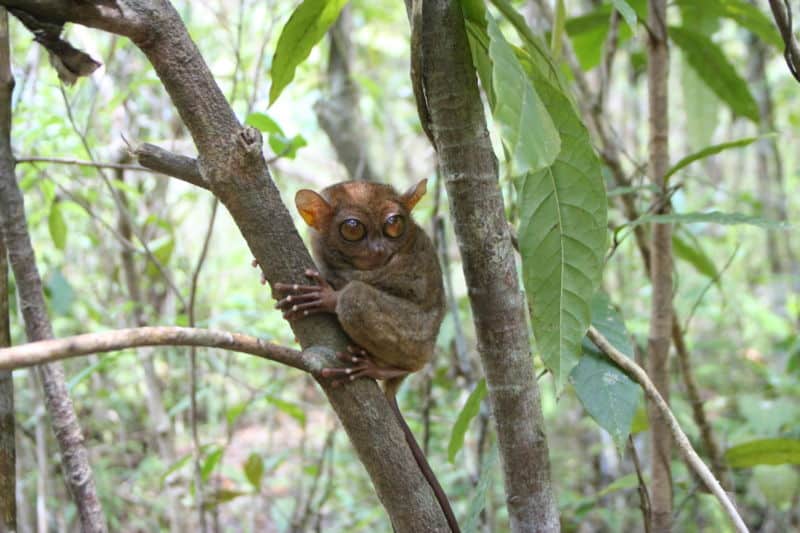
Despite controversies, all tarsiers have been placed in the genus
Tarsius.
The phylogenetic position of the extant tarsier species within the order Primates has been debated since the 20th century. Despite controversies, all tarsiers have been placed in the genus Tarsius at a lower phylogenetic level. In 2011, all the sub-species were divided into three groups based on their geographic location: Philippine Tarsiers, Eastern Tarsiers, and Western Tarsiers. Besides, more tarsiers are still being discovered on an ongoing basis.
Despite constant debate amongst scientists over the naming and classification of aye-aye species, the aye-aye was finally recognized as lemur species in the mid-1800s. Later in 2008, all lemur species were defined as monophyletic and contained five living families, including Daubentoniidae.
Tarsier vs Aye-Aye: Size
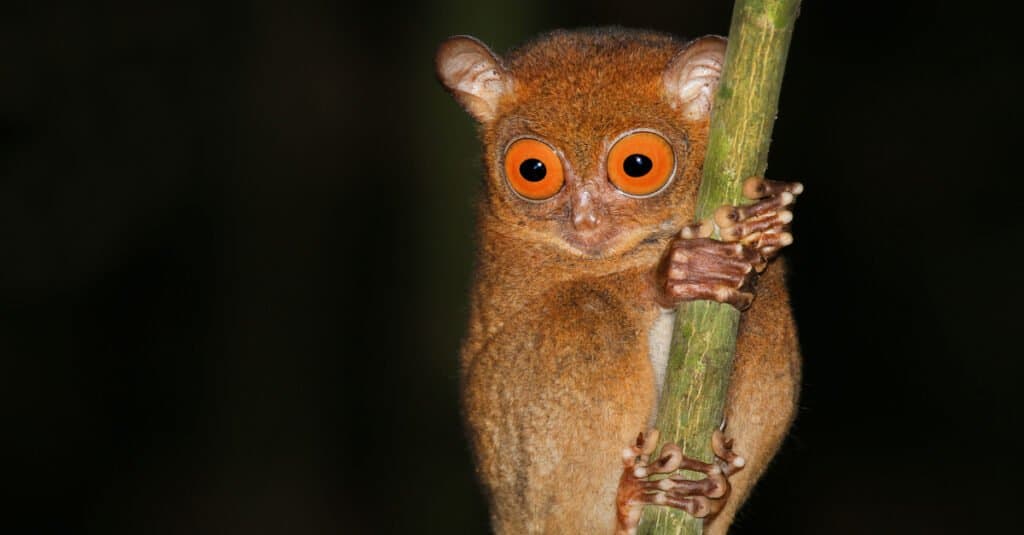
An adult tarsier stands between 3.5 and 6.3 inches in height and weighs approximately 80 to 165 g.
©Ryan M. Bolton/Shutterstock.com
Tarsiers are smaller than aye-ayes. An adult tarsier stands between 3.5 and 6.3 inches (9 cm and 16 cm) in height and weighs approximately 80 to 165 g (2.8 oz to 5.8 oz). They have distinct enormous eyes, measuring about 0.63 inches (16 millimeters) in diameter, sometimes larger than a tarsier’s entire brain. They have elongated fingers and slender tails.
Unlike tarsiers, aye-ayes are the world’s largest nocturnal primates. A full-grown aye-aye is typically 12 to 15 inches (30 to 40 cm) in length and weighs about 4 to 6 pounds (2 to 2.7 kg). Their tails are approximately 22 to 24 inches (56 to 61 cm) long, relatively longer than aye-aye’s entire body.
Tarsier vs Aye-Aye: Color
Tarsiers’ small, stocky bodies and long tails either have a tuft at the end or are sparsely covered in fur. Their soft, velvety fur varies from buff to beige or ochre, depending on the species.
On the contrary, fully matured aye-ayes are covered in fur that’s typically not one solid color. While aye-aye’s entire body is either brown or yellow, the ends of the hair on the head and back are predominantly tipped with white. Young aye-ayes have a stripe down their back and are silver colored on their front.
Tarsier vs Aye-Aye: Diet
Tarsiers are entirely carnivorous animals. Their favorite prey consists of arthropods such as grasshoppers, cockroaches, spiders, and beetles. They are also known to prey on bats, lizards, small snakes, and birds. Unlike tarsiers, aye-ayes are predominantly omnivores. Aye-ayes eat not only fungi, fruits, seeds, and nectar but also insect larvae and honey.
Tarsier vs Aye-Aye: Distribution and Habitat
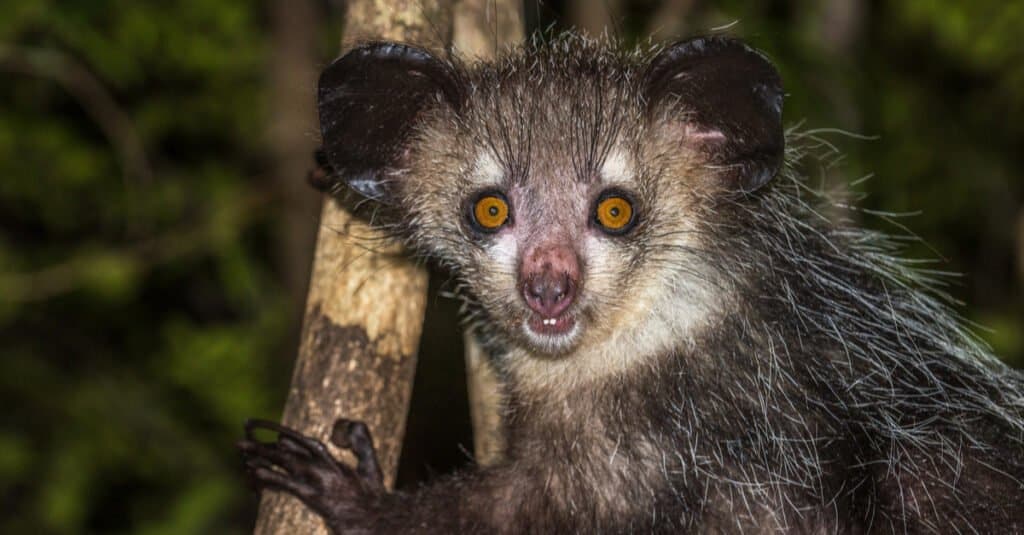
Aye-ayes prefer to inhabit rainforests or deciduous forests.
©javarman/Shutterstock.com
Tarsiers are primarily found in forested habitats and scrublands, especially where there is liana to give them vertical support when climbing trees. Most tarsier species are found in Maritime Southeast Asia, specifically in Brunei, Indonesia, Malaysia, and the Philippines.
As opposed to tarsiers, aye-ayes are found primarily on the east coast of Madagascar. Aye-ayes prefer to inhabit rainforests or deciduous forests, though they may also live in cultivated areas due to deforestation.
Tarsier vs Aye-Aye: Reproduction and Life Cycle
Tarsiers tend to breed all year round, except Spectral tarsiers, which tend to have more specific breeding seasons between April and November. The gestation period lasts roughly six months, and tarsiers give birth to a single offspring. Young tarsiers can climb within a day of birth. They are born covered in fur and with open eyes. They are weaned at about eight weeks and attain sexual maturity by the end of their second year.
The gestation period lasts for about five months in aye-ayes. Like the tarsiers, aye-ayes also give birth to a single offspring who spends its first two months in the safety of the nest. The young aye-aye is weaned at about 7 to 8 months. They attain sexual maturity in about 2 to 3 years.
Tarsier vs Aye-Aye: Lifespan
Most tarsier species live between 12 and 20 years, while the aye-ayes have an average lifespan of between 10 and 23 years. Due to their small size, tarsiers are vulnerable to predation by cats, owls, and snakes. Aye-ayes have very few natural predators in their native environment due to their secretive and tree-dwelling lifestyle. Deforestation and growing human settlements are some of the biggest threats to the aye-aye population.
Tarsier vs Aye-Aye: Conservation Status
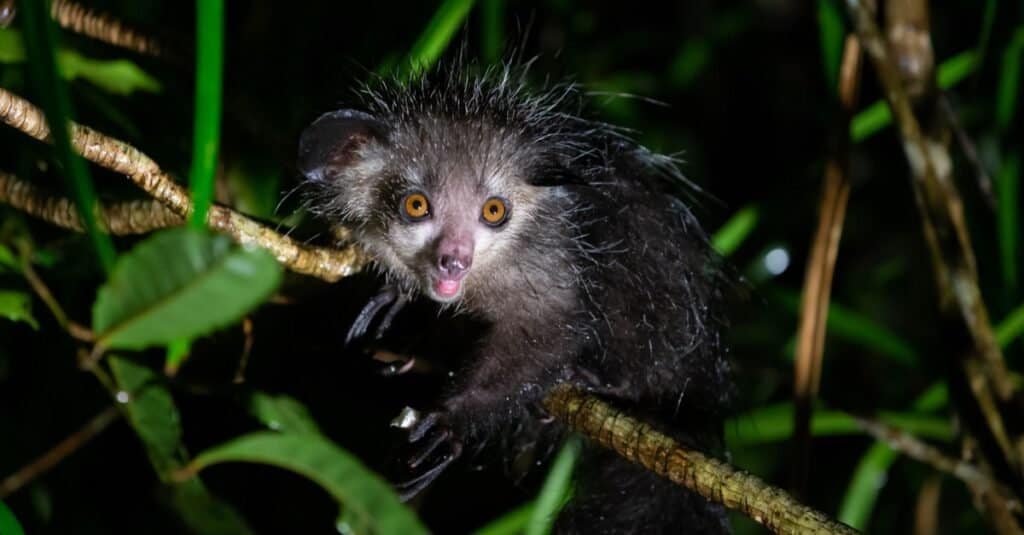
Aye-ayes were initially considered extinct in 1933 but rediscovered in 1957.
©Eugen Haag/Shutterstock.com
Depending on the species, most tarsiers are listed by the IUCN as either endangered, vulnerable, or critically endangered. Nevertheless, all tarsier species are vulnerable to extinction based on their conservation status.
In contrast, aye-ayes were initially considered extinct in 1933 but rediscovered in 1957. Numbers have increased somehow since the 1980s, and more aye-aye populations have been spotted in more areas within their natural range. However, aye-ayes are currently listed by the IUCN as endangered animals since they are still greatly threatened by human activity around them.
Up Next…
- 10 Incredible Aye Aye Facts
- The 5 Ugliest Monkeys In The World
- Scary Animals: The 10 Creepiest Animals in the World
The photo featured at the top of this post is ©
Thank you for reading! Have some feedback for us? Contact the AZ Animals editorial team.




